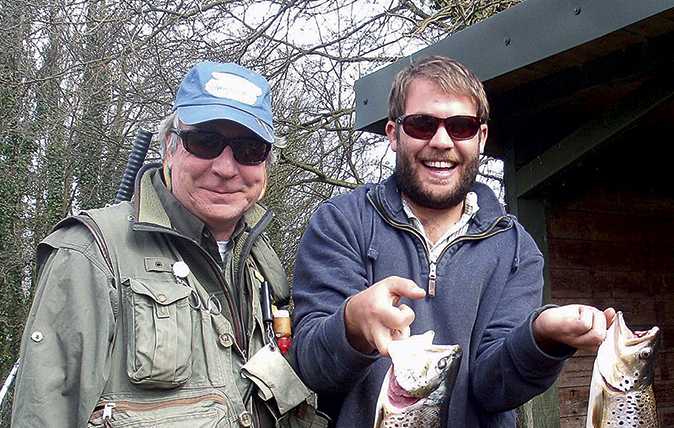Reel Life: A vintage year for trout
David Profumo has a rip-snorting year from Perthshire to Hampshire and looks forward to autumn success.


Although I miss out on much of the chalkstream year by dwelling in the Highlands, I’ve maintained my cherished membership of a club on the Itchen and it was there, on April 8, that my 2016 trout season got off to a rip-snorting start.
My friend, John Hotchkiss, and I began at the uppermost beat, where the water was clear as schnapps and good numbers of overwintered fish were in evidence. In the glide above our second hut, I espied a big brownie on the feed, wavering between two banners of weed, and, just before my little dry Humpy was about to skate and drag, he wolfed it down. Being in superb condition, he was kept for the freezer. That one weighed in at 5lb, 12oz—my largest ever from the club water.
So, it was already something of a red-letter day when we motored down to join the keepers (Peter and Philip) for a lunchtime drink. We’d landed several brace between us and the spring sun was shining on our endeavours. A hover of fish was finning below the willows and my luck was in, because, second cast, my fly was taken with a deceptively gentle, tilting rise—and, eventually, the net went under a trout of more than 4lb. I scarcely minded that I had to be ‘up North’ for most of the mayfly, after that.
Although there remain serious concerns about water quality on our chalkstreams, the Itchen this year enjoyed decent hatches of grannom and iron blue and I’m told there was also an exceptional run of sea trout. By then, I had taken up the longer rod and was chasing brownies of the Caledonian kind, particularly in two, very different house lochs.
Here in Perthshire, my ingenious neighbour Andrew—whose self-designed cutting boat has trimmed the vegetation as far away as Balmoral—was thinning out our weed growth when he almost bisected a brownie he swears was as long as his arm. I haven’t yet seen it again, but we had some good daytime sport, especially when the daddies were tumbling across the breeze like thistledown. Perhaps the big fella was finally winched out by those uninvited guests who also generously left behind their fag packets, cider tins and an unopened pot of wiggly worms.
Over in Harris, there’s a spectacular, rowan-girt lochan behind The Doctor’s house; the fish are elusive and few, but, once, a two-pounder fell to my Zulu. This year, with the chill winds, I managed just a solitary tiddler. They tend to stay down, concentrating on corixa and sticklebacks, although my persistence is spurred by the distant memory of a trout the size of a grilse slurping sedges among the reeds—back in August 1993!
In high summer, I nipped south to Hampshire again for a day on the exquisite little Dever—favoured venue of our peripatetic Bundha Club. We had three beats to ourselves and I began downstream with novelist Luke Jennings—among the stealthiest of anglers I know. Unless you creep around here, the trout spook away, herding their startled cousins ahead. There are also some canny big grayling with claret fins that sidle warily across the substrate. By the time we were tucking into the chicken and Sancerre at luncheon, we had each caught and released several of both species, on tiny nymphs.
Sign up for the Country Life Newsletter
Exquisite houses, the beauty of Nature, and how to get the most from your life, straight to your inbox.
I owe my success, partly, to some new ‘ceramic flies’ I recently mail-ordered from Stanislaus Freyheit and I thoroughly recommend visiting his website (www.french-nymphs.com). Heavy, streamlined, and deeply enticing, his orange spot gammarus shrimp (number H14) and the medium ceramic M21—olive-bodied with an orange bead head—have served me well for all my sight-fishing this season and I now carry dozens of them.
We also took a day at nearby Longstock Park Lake, on the immaculate Leckford estate. Back in the 1980s, at the time of the so-called ‘stillwater explosion’ when Sam Holland was developing his strain of ‘supertrout’ and practically every hole in the ground was being stocked with lumbering rainbows, I avidly used to fish such small southern waters. One visit to Avington yielded me a brace totalling 30lb.
The technique of ‘stalking‘ requires getting your weighted ‘bug’ down to the exact level of the cruising specimen and, for some decades, my ‘secret weapon‘ has been the tasty looking Croque Monsieur, a confection of lemonish Angora wool, ginger palmered hackle and a detached (latex) mayfly body tied in at the tail. The Longstock fish seemed to appreciate it—ambling up, pale mouth agape, to inhale it fluttering down the water column. The Croque accounted for four, the best just over 5lb—although not exactly classic chalkstream tactics, I admit.
And now we have the delicious prospect of autumn grayling.
David Profumo caught his first fish at the age of five, and, off the water, he’s a novelist and biographer. He lives up a glen in Perthshire.
Country Life is unlike any other magazine: the only glossy weekly on the newsstand and the only magazine that has been guest-edited by HRH The King not once, but twice. It is a celebration of modern rural life and all its diverse joys and pleasures — that was first published in Queen Victoria's Diamond Jubilee year. Our eclectic mixture of witty and informative content — from the most up-to-date property news and commentary and a coveted glimpse inside some of the UK's best houses and gardens, to gardening, the arts and interior design, written by experts in their field — still cannot be found in print or online, anywhere else.

